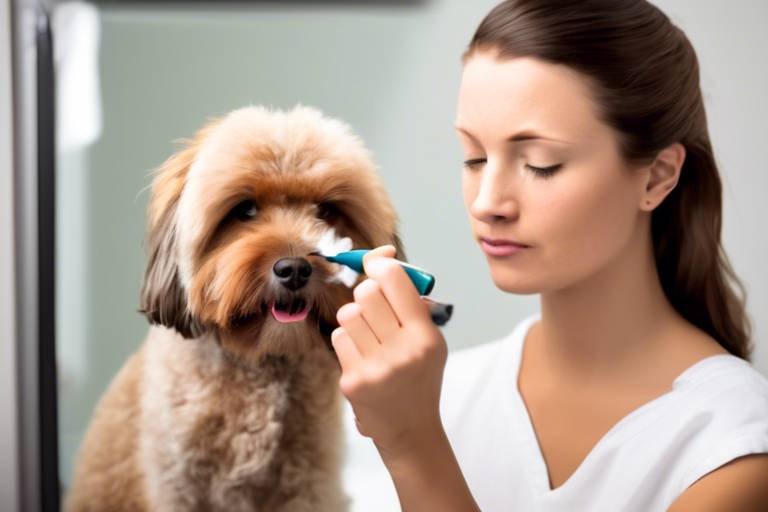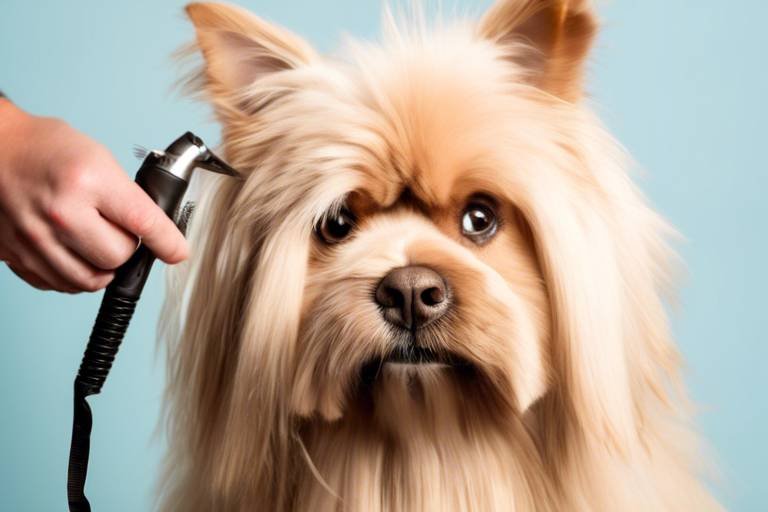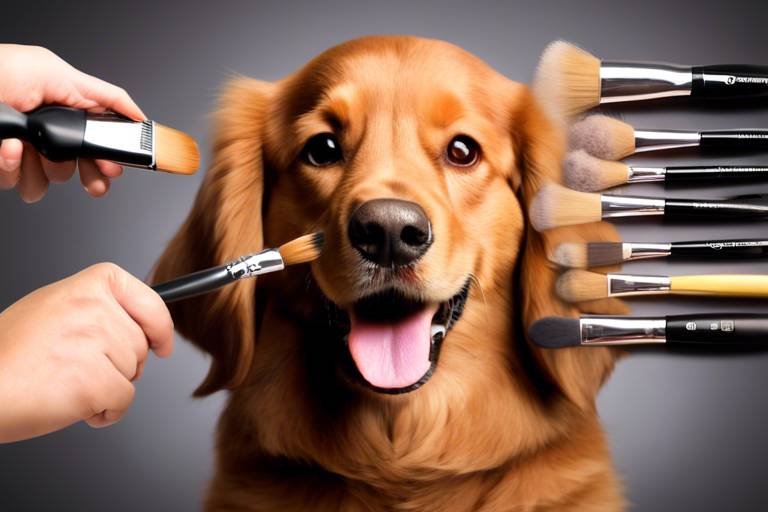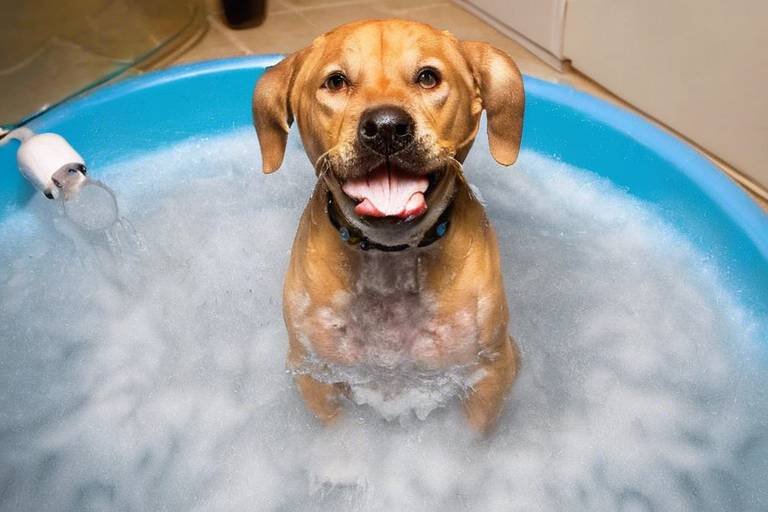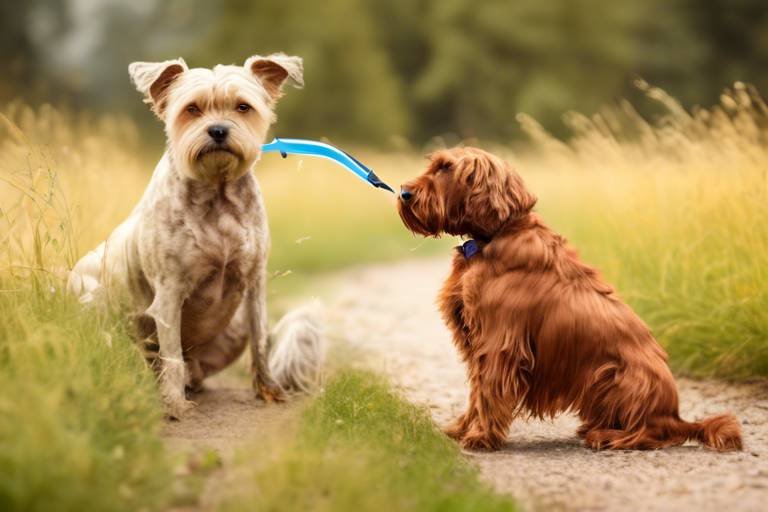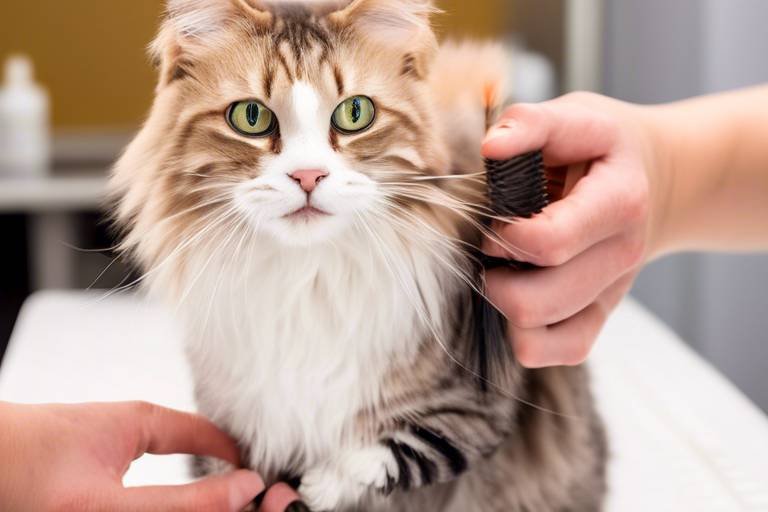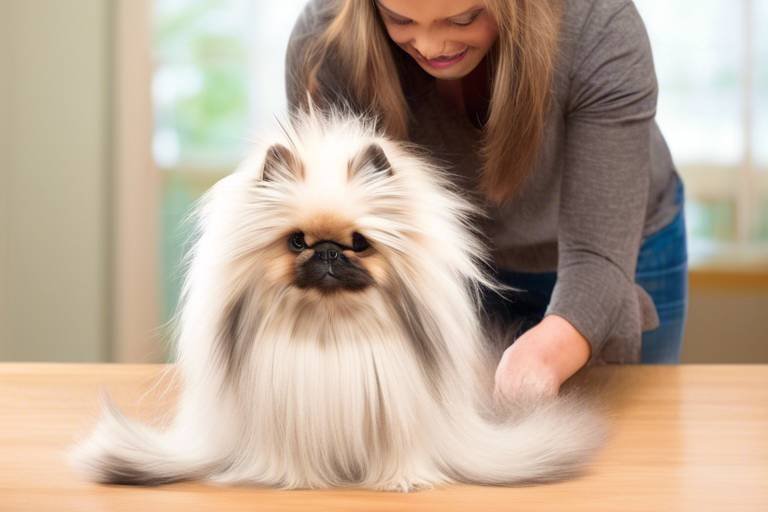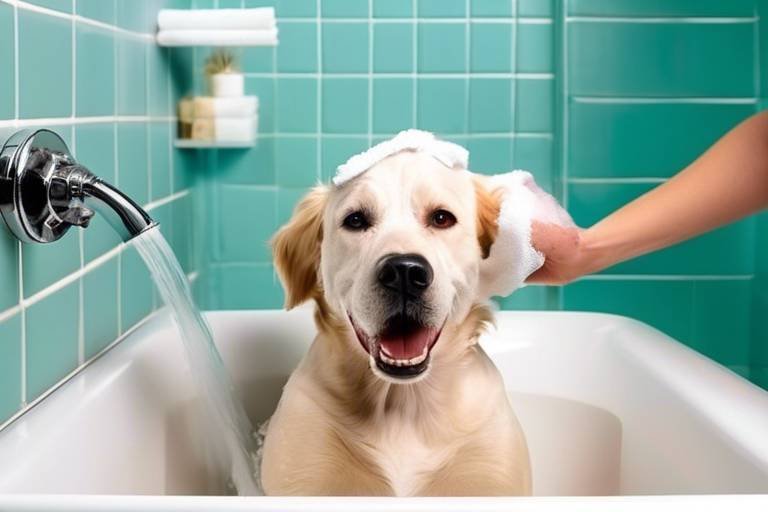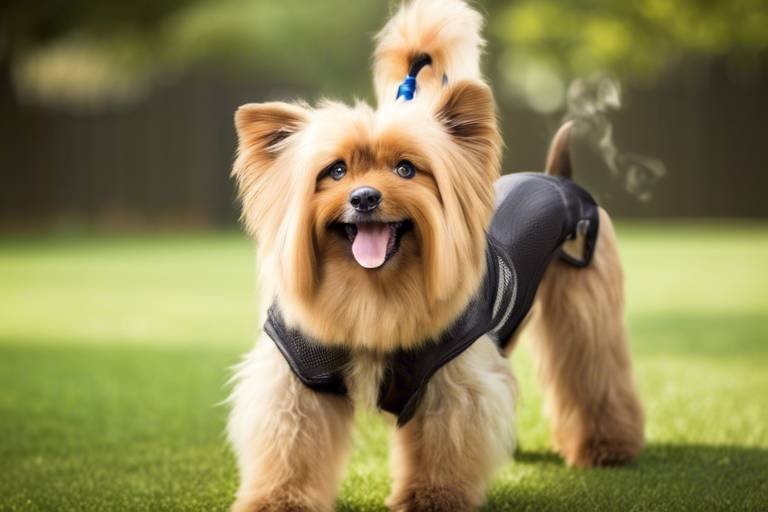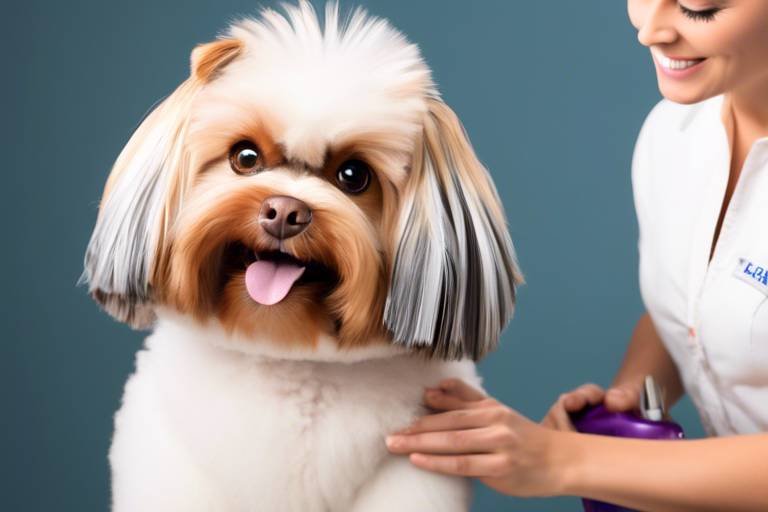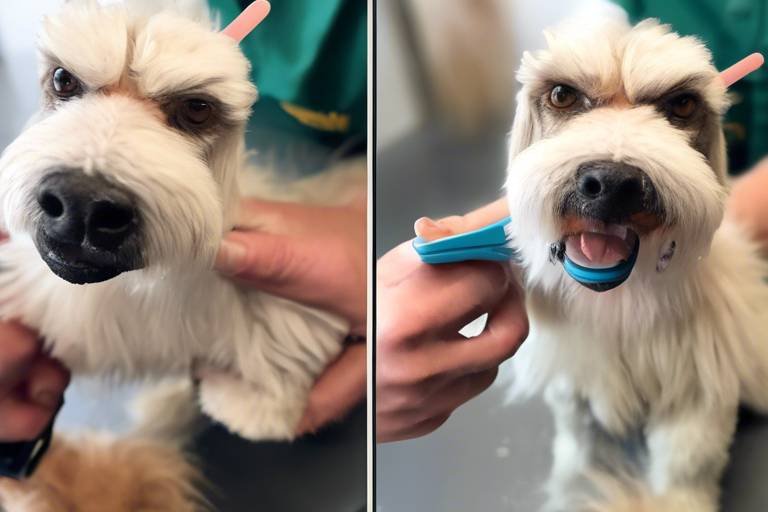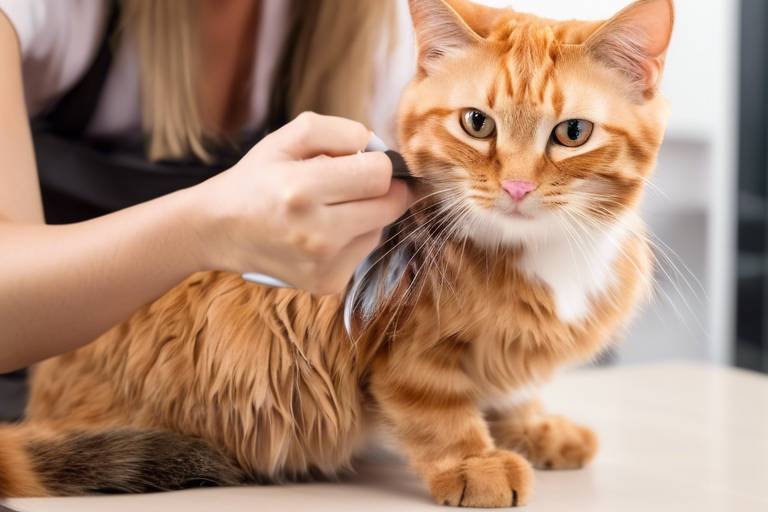How to Spot Allergies During Grooming Sessions
Grooming your furry friend is not just about keeping them looking fabulous; it's an essential part of their health and well-being. As pet owners, we often focus on the aesthetics, but what if grooming sessions could also unveil hidden allergies? Imagine brushing your dog or cat and suddenly noticing them scratching or sneezing—those could be signs of an allergic reaction! In this article, we'll explore how to spot allergies during grooming sessions, empowering you to be more observant and proactive in ensuring your pet's comfort.
Allergies in pets can manifest in various forms, similar to how we humans experience them. They can be a nuisance, causing discomfort and distress. Generally, allergies can be categorized into three main types: environmental, food, and contact allergies. Environmental allergies often arise from pollen, mold, and dust mites, while food allergies can stem from specific ingredients in their diet. Contact allergies might occur due to certain materials or substances that come in direct contact with your pet's skin. Understanding these types is crucial because it sets the stage for recognizing symptoms during grooming sessions.
Recognizing the symptoms of allergies during grooming is crucial for effective management. As you groom your pet, keep an eye out for key signs such as itching, redness, and swelling. These symptoms can be subtle at first, but if you notice your pet acting unusually or displaying discomfort, it’s time to pay closer attention. For instance, if your dog starts to shake its head frequently or your cat suddenly becomes restless, these could be indicators of an allergic reaction. By being vigilant, you can catch these symptoms early and take appropriate action.
Skin reactions are often the first indication of allergies. As you groom your pet, look for common skin issues like rashes, hives, and hot spots. These conditions can arise during grooming due to the introduction of allergens from grooming products or environmental factors. If you spot any unusual bumps or redness on your pet's skin, it might be time to investigate further. Remember, the earlier you identify these reactions, the better chance you have of alleviating your pet's discomfort.
Itching and scratching are frequent responses to allergens. If your pet is scratching excessively during grooming, it could be a sign of an allergic reaction. Think of it like a doggy alarm system going off—when they scratch, they’re trying to tell you something isn’t right. This behavior can lead to more severe skin issues if not addressed, so it’s essential to take note of how often your pet is itching. If the scratching becomes persistent, consider consulting your veterinarian for advice.
Redness and inflammation are clear signs of irritation. While grooming, assess your pet's skin for any signs of redness, which can indicate an allergic reaction. If you notice inflamed patches or areas that seem warm to the touch, it’s essential to take these symptoms seriously. They can signify that your pet is experiencing discomfort and may require immediate attention. Don’t hesitate to reach out to a professional if you’re unsure about the severity of the symptoms.
Respiratory symptoms can also indicate allergies. During grooming, keep an ear out for signs such as sneezing, coughing, and wheezing. These symptoms are often overlooked but can be just as critical as skin reactions. If your pet starts to cough or seems to have difficulty breathing, it could mean they are reacting to something in their environment or grooming products. In these cases, it's crucial to act quickly and consider consulting your veterinarian.
Identifying specific allergens is essential for effective management. During grooming sessions, be aware of common triggers that could affect your pet. Grooming products, for one, can contain potential allergens that may cause reactions. Opting for hypoallergenic shampoos and conditioners can minimize these risks significantly. Additionally, environmental factors such as pollen, dust mites, and even household cleaners can play a role in your pet's allergic responses. By being mindful of these triggers, you can create a safer grooming environment for your furry friend.
Many grooming products contain potential allergens. When selecting shampoos and conditioners, look for labels that indicate they are hypoallergenic. This can help reduce the likelihood of allergic reactions during grooming sessions. Additionally, it’s wise to perform a patch test with any new product before fully incorporating it into your grooming routine. A small amount on a less sensitive area can help you gauge your pet’s reaction without exposing them to potential allergens on a larger scale.
Environmental factors can greatly influence allergy symptoms. During grooming, consider the environment in which you’re working. Is there a lot of pollen in the air? Are there dust bunnies lurking in the corners? These elements can exacerbate your pet's allergic reactions. Regular cleaning and maintaining a dust-free environment can help mitigate these issues. Additionally, consider grooming your pet indoors during high pollen seasons to minimize exposure to outdoor allergens.
Knowing when to consult a veterinarian is important. If you notice persistent symptoms or if your pet seems to be in distress during grooming, it’s time to seek professional advice. Some signs that warrant a visit to the vet include severe itching that doesn’t subside, noticeable swelling, or respiratory issues like coughing or wheezing. Remember, your pet's health and comfort should always be your top priority, so don’t hesitate to reach out for help when needed.
- What are the most common allergens for pets? Common allergens include pollen, dust mites, certain foods, and specific grooming products.
- How can I tell if my pet has a food allergy? Look for symptoms like vomiting, diarrhea, or excessive itching after eating certain foods.
- Should I stop grooming my pet if they show signs of allergies? It’s best to consult your veterinarian for guidance on how to proceed without causing further discomfort.
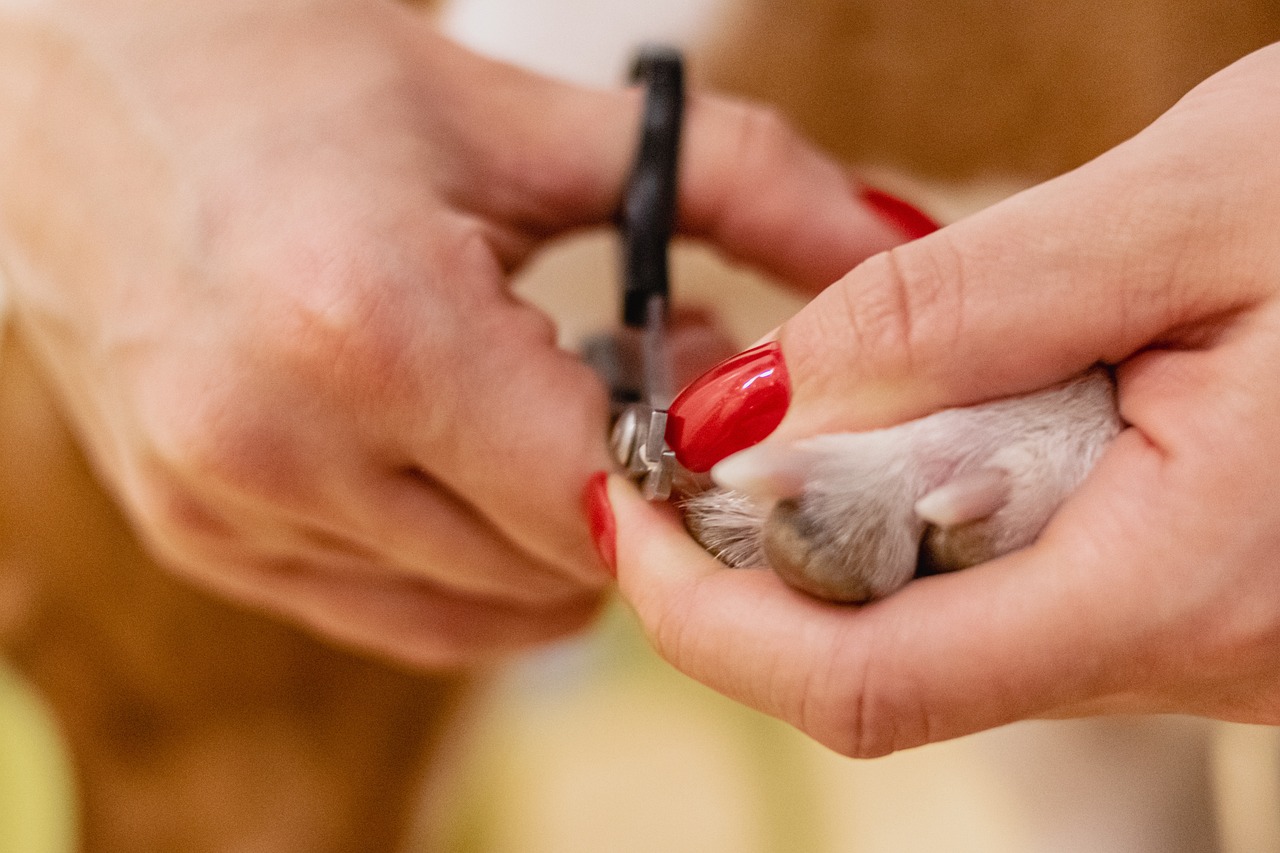
Understanding Allergies in Pets
Allergies in pets can be a complex and frustrating issue for both the furry friends and their owners. Just like humans, pets can experience a variety of allergic reactions that can significantly affect their quality of life. It's essential to understand that allergies can manifest in different ways, and recognizing these signs early can make a world of difference. There are three primary types of allergies that commonly affect dogs and cats: environmental allergies, food allergies, and contact allergies.
Environmental allergies are often triggered by substances in the pet's surroundings. Common culprits include pollen from trees and grasses, dust mites, mold spores, and even certain chemicals in household cleaning products. When pets inhale or come into contact with these allergens, their immune systems may overreact, leading to various symptoms. For instance, a dog may develop itchy skin or respiratory issues, while a cat might experience sneezing or watery eyes.
Food allergies are another prevalent issue. Pets can develop sensitivities to specific ingredients in their food, such as beef, chicken, dairy, or grains. This can lead to gastrointestinal problems or skin irritations. It's important for pet owners to be observant of any changes in their pet's behavior or health after introducing new foods. If a pet shows signs of discomfort, it may be time to consult with a veterinarian to determine if a food allergy is at play.
Contact allergies are less common but can still pose a significant problem. These occur when pets come into direct contact with allergens, such as certain fabrics, flea treatments, or grooming products. For example, if a dog develops a rash after a grooming session, it's possible that one of the products used contained an ingredient that triggered an allergic reaction. This highlights the importance of choosing hypoallergenic grooming products whenever possible.
To summarize, understanding the types of allergies that can affect pets is crucial for effective management. Here’s a quick overview:
| Type of Allergy | Common Triggers | Symptoms |
|---|---|---|
| Environmental Allergies | Pollen, dust mites, mold, chemicals | Itchy skin, sneezing, watery eyes |
| Food Allergies | Beef, chicken, dairy, grains | Gastrointestinal issues, skin irritations |
| Contact Allergies | Fabrics, grooming products, flea treatments | Rashes, hives, localized swelling |
By being aware of these allergies and their potential triggers, pet owners can take proactive steps to protect their beloved companions. Regular grooming sessions are an excellent opportunity to observe any changes in your pet's skin or behavior. If you notice anything unusual, such as excessive scratching or changes in mood, it’s essential to investigate further. After all, a happy pet means a happy home!

Common Symptoms to Watch For
Recognizing the symptoms of allergies during grooming is crucial for the health and well-being of your furry friends. Just like humans, pets can exhibit a variety of reactions to allergens that can be quite alarming if you’re not prepared. During grooming sessions, it’s important to keep an eye out for certain telltale signs that might indicate your pet is having an allergic reaction. If you notice any unusual behavior or physical changes, it’s best to investigate further. After all, our pets can’t tell us what’s wrong, so we need to be their voice!
One of the most common symptoms to watch for is itching. If your pet is scratching more than usual, it could be a sign that they are experiencing discomfort due to an allergic reaction. This excessive scratching can lead to skin irritation or even open wounds, which can become infected. So, if you see your dog or cat constantly pawing at their face or body, pay attention! It might be time to check for allergens.
Another significant symptom is redness and inflammation. If you notice any areas of your pet's skin that appear red, swollen, or irritated, this could indicate an allergic reaction. These symptoms are often accompanied by other issues, such as rashes, hives, or even hot spots. These skin reactions are often the first indication that something is off, and they can escalate quickly if not addressed. For instance, hot spots can become quite painful for your pet and require immediate attention.
In addition to skin reactions, respiratory symptoms can also signal allergies. Be on the lookout for signs such as sneezing, coughing, or wheezing during grooming. These symptoms can be particularly concerning, as they may indicate that your pet is experiencing difficulty breathing due to allergens in the air or grooming products. If your pet starts to exhibit these symptoms, it’s essential to stop grooming immediately and assess the situation.
To summarize, here are some common symptoms to watch for during grooming:
- Itching and Scratching: Excessive scratching can lead to skin damage.
- Redness and Inflammation: Look for irritated areas on the skin.
- Respiratory Symptoms: Sneezing, coughing, or wheezing may indicate airborne allergens.
Understanding these symptoms can help you act quickly and effectively when it comes to your pet's health. If you notice any of these signs, consider adjusting your grooming routine or consulting with a veterinarian to ensure your pet remains happy and healthy.
Q1: How can I tell if my pet is having an allergic reaction during grooming?
A1: Look for signs such as excessive scratching, redness, inflammation, or respiratory issues like sneezing or coughing. If you notice any of these symptoms, it’s best to stop grooming and assess the situation.
Q2: What should I do if my pet shows signs of an allergic reaction?
A2: Stop grooming immediately and check for any visible irritants. If symptoms persist, consult your veterinarian for advice on how to manage your pet's allergies.
Q3: Are there specific grooming products that are better for pets with allergies?
A3: Yes! Look for hypoallergenic shampoos and conditioners that are free from common allergens. Always read labels and consider consulting your vet for recommendations.
Q4: Can environmental factors contribute to my pet's allergies during grooming?
A4: Absolutely! Pollen, dust mites, and other environmental allergens can significantly affect your pet's allergy symptoms. Be mindful of the environment during grooming sessions.
Skin Reactions
When it comes to our furry friends, can be one of the most alarming signs of allergies, especially during grooming sessions. Imagine your pet, usually so full of life and energy, suddenly becoming agitated or uncomfortable. This is often the first indication that something is amiss. Skin reactions can manifest in various ways, such as rashes, hives, and hot spots. Each of these conditions can be quite distressing for both pets and their owners, and it's crucial to recognize them early to ensure proper care.
Rashes can appear as red, inflamed patches on the skin, often accompanied by excessive scratching or licking. They may be localized or spread across larger areas, depending on the severity of the allergic reaction. Hives, on the other hand, are raised welts that can appear suddenly and may cause your pet to feel itchy and uncomfortable. Hot spots, or acute moist dermatitis, are another common skin issue that can develop rapidly, often as a result of incessant scratching or licking. These spots are typically red, swollen, and can ooze, making them not just uncomfortable but also prone to infection if not treated promptly.
It's important to keep an eye out for any changes in your pet's skin during grooming. If you notice any of the following symptoms, it may indicate an allergic reaction:
- Redness: Look for areas of skin that appear more red than usual, which can indicate inflammation.
- Swelling: Any swelling in the skin can be a sign of an allergic response.
- Flaky or Scaly Skin: This can suggest irritation or an underlying allergy.
- Excessive Grooming: If your pet is licking or biting at their skin more than usual, it could be a reaction to something they encountered during grooming.
Understanding these skin reactions is vital for pet owners. If you suspect that your pet is experiencing an allergic reaction, acting quickly is essential. Consult your veterinarian for guidance on the best course of action, which may include allergy testing or switching to hypoallergenic grooming products. Remember, a little vigilance during grooming can go a long way in ensuring the health and happiness of your beloved pet.
1. What are the most common skin reactions in pets?
Common skin reactions include rashes, hives, and hot spots. These can develop due to allergies triggered by grooming products or environmental factors.
2. How can I tell if my pet has a skin allergy?
Look for signs such as redness, swelling, excessive scratching, or flaky skin. If you notice these symptoms, consult your veterinarian.
3. Are there hypoallergenic grooming products available?
Yes, many brands offer hypoallergenic shampoos and conditioners designed to minimize allergic reactions. Always check the label for potential allergens.
4. When should I take my pet to the vet for skin reactions?
If your pet shows persistent symptoms, develops open sores, or if the reaction worsens, it's time to seek veterinary advice.
Itching and Scratching
Itching and scratching are often the first signs that something is off with your furry friend. Imagine this: your dog or cat is happily enjoying a grooming session, and suddenly, they start to scratch as if they’ve been attacked by a swarm of invisible bugs. This behavior isn't just a quirky moment; it's a clear indication that your pet may be experiencing an allergic reaction. So, what causes this incessant scratching? Well, allergens can trigger a response in your pet's skin, leading to discomfort and irritation.
When you notice your pet scratching excessively, it’s like a red flag waving in the wind. Allergens can come from various sources, including grooming products, environmental factors, or even certain foods. For example, if you just applied a new shampoo, it might contain ingredients that irritate your pet's skin. Some common allergens include fragrances, preservatives, and certain proteins. Therefore, it’s crucial to be aware of the products you use during grooming.
In addition to the products, consider how your pet's environment might contribute to their scratching. Dust mites, pollen, and even mold can find their way into your home and affect your pet's skin. If your pet seems to scratch more after spending time outdoors, it could be a sign that they are reacting to environmental allergens.
To help you identify the potential causes of your pet's itching, here’s a quick breakdown of common allergens:
| Allergen Type | Examples |
|---|---|
| Grooming Products | Shampoos, conditioners, sprays |
| Environmental | Pollen, dust mites, mold |
| Food | Chicken, beef, dairy |
If your pet is scratching excessively, it’s essential to take action. Start by examining their skin for any signs of redness or irritation. You might also want to consider switching to hypoallergenic grooming products that are specifically formulated to minimize allergic reactions. These products can provide relief and make grooming a more pleasant experience for both you and your pet.
In conclusion, keeping an eye on your pet's scratching habits during grooming sessions is vital for their overall health and well-being. If you notice persistent itching or if it seems to worsen, don’t hesitate to consult your veterinarian. They can help you determine the underlying cause and recommend the best course of action to ensure your pet remains comfortable and happy.
- What should I do if my pet is scratching a lot? If your pet is scratching excessively, check for any obvious irritants, and consider switching to hypoallergenic products. If the scratching continues, consult a veterinarian.
- Can I use human shampoo on my pet? No, human shampoos can contain ingredients that are harmful to pets. Always use products designed specifically for animals.
- How can I prevent allergies in my pet? Regular grooming, using hypoallergenic products, and maintaining a clean environment can help reduce the risk of allergies in pets.
Redness and Inflammation
When it comes to spotting allergies in your furry friend during grooming sessions, are two of the most telling signs. Imagine your pet's skin as a warning system—when it lights up in red, it's trying to tell you something isn't quite right. This redness can often be localized to specific areas, such as the face, paws, or belly, indicating that these spots are reacting to some allergen present during the grooming process.
Inflammation, on the other hand, is like the body's alarm system going off. It occurs when the immune system kicks into high gear, attempting to fight off what it perceives as a threat. You might notice that the affected areas not only appear red but may also feel warm to the touch. This can be particularly concerning, as it might lead to more serious skin issues if left unchecked. In severe cases, the inflamed skin can become flaky or develop crusty patches, which can be uncomfortable for your pet and concerning for you as a pet owner.
So, how can you assess redness and inflammation effectively? Here are a few tips:
- Visual Inspection: Regularly check your pet's skin for any changes in color or texture.
- Touch Test: Gently feel the areas that look red. If they feel warm or tender, it’s a sign that inflammation is present.
- Monitor Behavior: If your pet seems more irritable or is scratching at a specific area, it’s worth investigating further.
In some cases, redness may not be the only symptom. It could accompany other signs like swelling or even discharge, which can indicate a more serious allergic reaction. If you notice these symptoms persisting or worsening, it’s crucial to consult your veterinarian. They can help determine whether it’s an allergic reaction or a different skin condition altogether. Remember, early detection is key to preventing more severe health issues down the line.
In summary, paying attention to redness and inflammation during grooming sessions can be your first line of defense against allergies. By being proactive and observant, you can ensure that your beloved pet remains happy and healthy.
- What should I do if I notice redness on my pet's skin? If you observe redness, it's best to consult your veterinarian to determine the cause and appropriate treatment.
- Can grooming products cause skin redness? Yes, many grooming products can contain allergens that may cause skin irritation and redness. Opt for hypoallergenic products whenever possible.
- How can I prevent allergies during grooming? Regularly clean your grooming tools, choose the right products, and keep an eye on environmental factors like pollen and dust.
Respiratory Symptoms
When it comes to our furry friends, their well-being is often intertwined with how they respond to their environment. During grooming sessions, it’s essential to be vigilant about any that may arise. These symptoms can serve as crucial indicators of allergies, which can affect your pet’s overall health and happiness. Imagine brushing your dog’s fur, and suddenly, they start sneezing or coughing—this could be more than just a reaction to dust. It might signal an allergic response!
Common respiratory symptoms to watch for during grooming include:
- Sneezing: A sudden bout of sneezing can indicate that your pet is reacting to allergens in the air or on their skin.
- Coughing: Frequent coughing can be a sign that your pet is trying to clear their airways from irritants.
- Wheezing: If your pet is wheezing, it can indicate that their airways are constricted, often due to an allergic reaction.
These symptoms may not always be immediately apparent but can develop over time, especially if your pet is consistently exposed to allergens during grooming. For instance, if you notice your dog is more prone to coughing after using a particular shampoo, it may be time to reassess the products you’re using. It’s like having a friend who suddenly starts sneezing every time they visit your house; it’s a clear sign that something in the environment isn’t sitting well with them.
Additionally, respiratory symptoms can sometimes be accompanied by other signs, such as watery eyes or nasal discharge. If you observe a combination of these symptoms, it’s crucial to take action. Remember, an allergic reaction can escalate quickly, so staying alert during grooming can make a world of difference in your pet’s health.
In summary, being aware of respiratory symptoms during grooming sessions is vital. These signs can help you identify potential allergies and take appropriate measures to ensure your pet remains comfortable and healthy. If your pet displays any of these symptoms consistently, it’s advisable to consult your veterinarian for further evaluation and possible allergy testing.
Q: What should I do if I suspect my pet has allergies?
A: If you suspect your pet has allergies, observe their symptoms closely and consult your veterinarian. They can perform tests to identify specific allergens and recommend treatment options.
Q: Can I use human grooming products on my pet?
A: No, human grooming products can contain ingredients that are harmful to pets. Always use products specifically designed for animals to avoid allergic reactions.
Q: How can I minimize allergens during grooming?
A: To minimize allergens, choose hypoallergenic grooming products, groom in a clean environment, and consider using air purifiers to reduce airborne allergens.
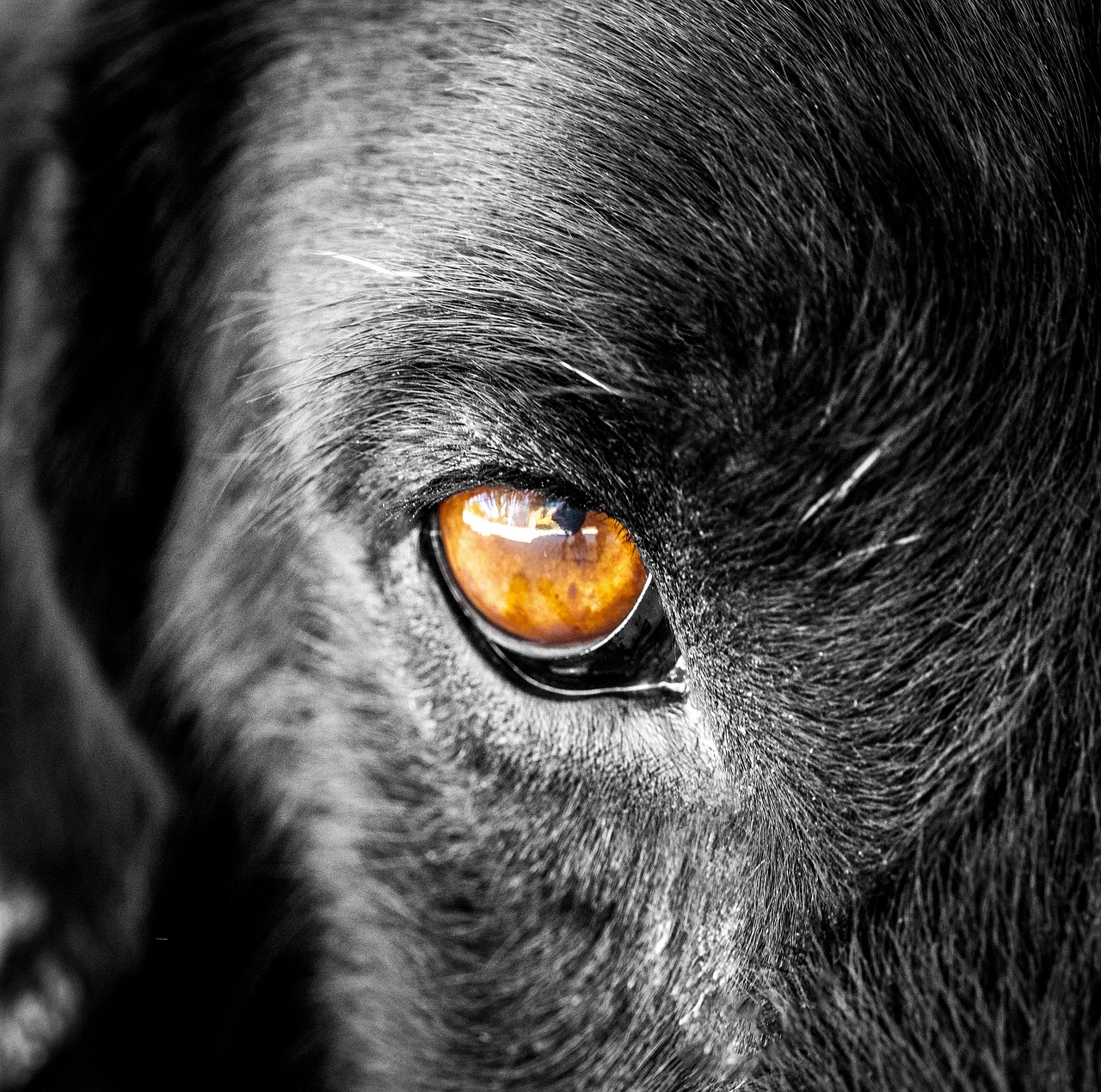
Identifying Triggers
Identifying specific allergens is crucial for effective management of allergies in pets. Just like a detective piecing together clues, pet owners need to be observant and proactive in recognizing what might be causing their furry friends discomfort. Allergens can lurk in various places, and understanding these triggers can make a significant difference in your pet's grooming experience and overall well-being.
First and foremost, let’s talk about grooming products. Many shampoos, conditioners, and even grooming tools can contain harsh chemicals or fragrances that may irritate your pet's skin. When selecting grooming products, it’s essential to look for hypoallergenic options. These products are designed to minimize allergic reactions and are often free from common irritants. Always check the ingredient list and, when in doubt, consult your veterinarian for recommendations that suit your pet’s specific needs.
Next up are environmental factors. Just as humans can suffer from seasonal allergies, pets can also be affected by pollen, dust mites, mold, and even certain types of grass. If your pet seems to have allergic reactions during certain times of the year, it might be worth keeping track of when these symptoms arise. For example, if your dog starts sneezing uncontrollably during springtime walks, it could be due to pollen. A simple way to manage this is to limit outdoor exposure during high pollen counts or to wipe your pet's paws and coat after walks to remove allergens that may have clung to them.
To help you better understand potential triggers, here’s a table summarizing common allergens found in grooming products and environments:
| Allergen Type | Examples | Symptoms |
|---|---|---|
| Grooming Products | Shampoos, conditioners, fragrances | Itching, redness, swelling |
| Environmental | Pollen, dust mites, mold | Sneezing, coughing, wheezing |
| Food | Grains, dairy, specific proteins | Vomiting, diarrhea, skin irritation |
Additionally, it’s important to observe your pet’s behavior during grooming sessions. If you notice any signs of discomfort, take a moment to reassess what products you’re using or what environmental factors might be at play. Sometimes, even a simple change in your grooming routine can lead to a happier, healthier pet.
By staying vigilant and informed about potential triggers, you can create a more comfortable grooming experience for your pet. Remember, your furry companion relies on you to keep them safe and healthy. So, take the time to investigate and identify those pesky allergens, and your pet will thank you with wagging tails and purrs!
- What are the common signs of allergies in pets? Look out for symptoms like itching, redness, swelling, sneezing, and coughing.
- How can I choose the right grooming products? Opt for hypoallergenic products and always check ingredient labels for potential irritants.
- When should I consult a veterinarian? If your pet shows severe symptoms or if home remedies do not alleviate their discomfort, it’s best to seek professional advice.
Grooming Products
When it comes to grooming our beloved pets, the products we choose can significantly impact their health and well-being. Many grooming products, such as shampoos, conditioners, and sprays, can contain a variety of ingredients that may trigger allergic reactions in sensitive pets. It's essential to be a savvy shopper and understand what to look for when selecting grooming products. Not all grooming products are created equal, and some may contain harsh chemicals or allergens that can cause discomfort for your furry friend.
First and foremost, consider opting for hypoallergenic grooming products. These products are specifically formulated to minimize the risk of allergic reactions. They often avoid common irritants such as fragrances, dyes, and harsh detergents. When reading labels, look for terms like "sensitive skin," "fragrance-free," or "allergy-tested." Here’s a quick table of common ingredients to avoid:
| Ingredient | Potential Effect |
|---|---|
| Parabens | Can cause skin irritation |
| Sulfates | May strip natural oils, leading to dryness and irritation |
| Artificial Fragrances | Common allergens that can irritate sensitive skin |
| Alcohol | Can dry out the skin and cause irritation |
Additionally, it's wise to conduct a patch test before using a new product on your pet. Apply a small amount of the product to a discreet area of their skin and monitor for any adverse reactions over 24 hours. This simple step can save you from a grooming disaster!
Another consideration is the type of grooming tools you use. Brushes, combs, and clippers can also harbor allergens, especially if they are not cleaned regularly. Make it a habit to wash grooming tools after each use to prevent the buildup of dirt, dander, and allergens. A clean tool is not only better for your pet's skin but also for their overall health.
Ultimately, the key is to be proactive. By choosing the right grooming products and maintaining a clean grooming environment, you can significantly reduce the risk of allergic reactions in your pets. Remember, their comfort and health should always come first!
- What are the signs my pet is having an allergic reaction during grooming? Look for symptoms such as excessive itching, redness, swelling, or respiratory issues.
- Should I consult my veterinarian before trying new grooming products? Yes, especially if your pet has a history of allergies or skin sensitivities.
- How often should I groom my pet to prevent allergies? Regular grooming is essential, but the frequency depends on your pet's breed and coat type.
- Are there any specific brands of hypoallergenic grooming products you recommend? While specific recommendations may vary, always look for reputable brands that focus on sensitive skin formulations.
Environmental Factors
When it comes to spotting allergies in pets, play a significant role. Just like humans, our furry friends can react to various elements in their surroundings. Imagine walking through a beautiful park filled with blooming flowers; while it may be a delightful experience for you, it could be a nightmare for your pet if they’re sensitive to pollen. Allergens are often lurking in places we least expect, and understanding these can make all the difference during grooming sessions.
One of the most common environmental triggers for allergies in pets includes pollen. During certain seasons, especially spring and fall, the air is thick with pollen from trees, grasses, and flowers. This can lead to sneezing, itching, and other allergy symptoms in pets. Additionally, dust mites are another culprit. They thrive in household environments, particularly in bedding and carpets. Regular cleaning and grooming can help minimize exposure to these pesky little creatures.
Other environmental factors to keep in mind include:
- Mold Spores: These can grow in damp areas of your home and can trigger allergic reactions.
- Smoke and Pollution: Just like us, animals can be sensitive to smoke from cigarettes or pollution from vehicles.
- Seasonal Changes: Changes in weather can bring about different allergens, making it essential to monitor your pet’s reactions throughout the year.
It's crucial to observe your pet closely during grooming sessions. If you notice any signs of discomfort, it could be linked to environmental allergens. For instance, if your dog starts sneezing or scratching excessively while you're brushing them after a walk in the park, it might be worth investigating further. Keeping a diary of your pet's grooming routine alongside their symptoms can help you identify patterns and potential triggers.
Moreover, consider the products you’re using during grooming. Many shampoos and conditioners can contain fragrances or chemicals that might irritate your pet's skin, especially if they are already sensitive to environmental factors. Opting for hypoallergenic grooming products can significantly reduce the risk of allergic reactions. Always read labels carefully and consult with your veterinarian if you're unsure about which products to use.
In summary, being aware of environmental factors is vital for identifying allergies in pets. By paying attention to potential allergens in your home and during grooming, you can help ensure your furry friend remains comfortable and healthy.
Q: How can I tell if my pet has an allergy?
A: Look for symptoms like itching, redness, sneezing, or coughing. If these occur during grooming, it may indicate an allergic reaction.
Q: What should I do if I suspect my pet has allergies?
A: Consult your veterinarian for a proper diagnosis and advice on managing your pet's allergies.
Q: Are there specific grooming products that are better for allergic pets?
A: Yes, hypoallergenic shampoos and conditioners are designed to minimize allergic reactions. Always choose products labeled as such.
Q: Can environmental changes affect my pet's allergies?
A: Absolutely! Seasonal changes can introduce new allergens, so it's important to monitor your pet's reactions throughout the year.

When to Seek Veterinary Help
Recognizing when your furry friend needs professional help can be a game changer in managing their allergies effectively. As a pet owner, you might find yourself wondering, "Is this just a minor issue, or should I be worried?" Well, there are specific signs that should prompt you to pick up the phone and call your veterinarian.
First and foremost, if you notice that your pet's symptoms are persistent or worsening, it's time to seek help. For instance, if your pet is scratching excessively, and you’ve tried various remedies without any improvement, this could indicate a more serious underlying issue that needs professional attention. Allergies can lead to more severe conditions like skin infections if left untreated.
Another critical factor to consider is the presence of severe symptoms. If your pet is experiencing significant swelling, especially around the face, or if they are having difficulty breathing, it’s crucial to act quickly. These could be signs of an anaphylactic reaction, which is a medical emergency. In such cases, don’t hesitate—contact your veterinarian or an emergency animal clinic immediately.
Moreover, if you observe any unusual behavior in your pet, such as lethargy, vomiting, or diarrhea, these could be signs that the allergies are affecting their overall health. It's essential to remember that pets can’t communicate their discomfort verbally, so any changes in their behavior should be taken seriously.
In addition to these signs, consider keeping a close eye on the timing of your pet's allergic reactions. If you notice that symptoms consistently arise after grooming sessions or exposure to specific products, it might be worth discussing this with your vet. They can help you identify potential allergens and suggest alternative grooming products that are less likely to trigger a reaction.
Lastly, don’t underestimate the importance of regular check-ups. If your pet has a history of allergies, routine visits to the vet can help monitor their condition and adjust treatment plans as needed. It’s much easier to manage allergies when you have a professional's guidance and support.
In summary, knowing when to seek veterinary help can make all the difference in your pet's comfort and health. If you notice persistent symptoms, severe reactions, unusual behavior, or have concerns about specific triggers, don’t hesitate to reach out to your veterinarian. Your furry friend deserves the best care possible, and sometimes that means getting a professional opinion.
- What are the most common signs of allergies in pets? Look for symptoms like itching, redness, swelling, and respiratory issues such as sneezing or coughing.
- When should I take my pet to the vet for allergies? If symptoms persist, worsen, or if your pet shows signs of severe reactions, it’s time to consult a veterinarian.
- Can I use human allergy medications on my pet? No, always consult your veterinarian before giving any medication to your pet, as some human medications can be harmful to animals.
- How can I prevent allergies in my pet? Regular grooming, using hypoallergenic products, and keeping your home clean can help minimize exposure to allergens.
Frequently Asked Questions
- What are the common signs of allergies in pets during grooming?
When grooming your furry friend, keep an eye out for signs like itching, redness, and swelling. These symptoms can indicate an allergic reaction, and noticing them early can help you address the issue before it worsens.
- How can I identify what my pet is allergic to?
Identifying specific allergens can be tricky, but start by observing your pet's reactions to different grooming products or environmental changes. Common triggers include ingredients in shampoos, dust mites, or even pollen. Keeping a diary of when symptoms occur can help pinpoint the culprit!
- Are hypoallergenic grooming products effective?
Yes! Using hypoallergenic shampoos and conditioners can significantly reduce the risk of allergic reactions during grooming sessions. However, it's essential to check the ingredients, as not all hypoallergenic products are created equal.
- What should I do if my pet shows symptoms of an allergic reaction?
If you notice signs like excessive scratching or inflammation, it's crucial to act quickly. First, stop the grooming session and assess the situation. If symptoms persist or worsen, consult your veterinarian for further advice.
- When is it necessary to seek veterinary help for my pet's allergies?
You should seek veterinary help if your pet experiences severe symptoms, such as difficulty breathing, persistent vomiting, or if the skin reactions do not improve. Early intervention can make a significant difference in your pet's health!
- Can environmental factors contribute to my pet's allergies?
Absolutely! Environmental factors like pollen, dirt, and dust mites can significantly affect your pet's allergy symptoms. Regular cleaning and minimizing exposure to allergens can help keep your pet comfortable.

